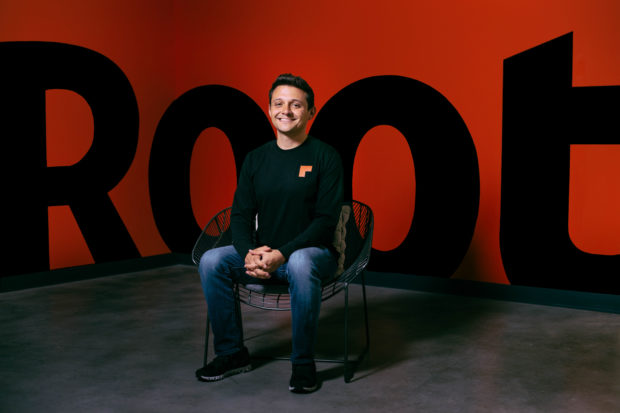Having achieved unicorn status with a $1 billion valuation less than two years after its official October 2016 debut, InsurTech carrier Root Insurance Company may seem like an overnight success.
Executive Summary
When actuary Alex Timm decided to launch a telematics-based auto insurance company, traditional insurers had already been experimenting with the idea—and failing to gain traction. Here, Timm tells Carrier Management that focusing on the best drivers has been one key to success, but he admits that nothing is really easy when starting to build an insurance company based on a reimagined pricing and delivery system. Persisting through startup challenges, Root leaders have created a company that generates premium revenues today and houses software products that could be a bigger portion of future revenue, he notes.The growth trajectory is hard to miss, whether measured by VC funding dollars, premiums, employee counts, app downloads or ZIP codes served (see “Root by the Numbers”). Most recently valued at nearly $3.7 billion, the company that set out to reinvent how auto insurance is priced and delivered to customers even announced an expansion into the renters insurance market in November 2019.
But the early days were slow going, recalls Chief Executive Officer Alex Timm.
“We didn’t even know if we were going to sell a single policy. When you first start, you don’t know really what the market response is going to be and, quite frankly, when we launched the app originally, we got almost no traction at all,” he told Carrier Management.
“We had to really iterate through on how we could actually drive demand both through our marketing channels and on the app itself. What new features do we [try] to actually get consumers to begin sharing the app? [All] that took a lot of experimentation.”
Customers who seek to download the app on their smartphones today see the tagline “Good drivers save money,” which sums up the reason Timm believes Root ultimately succeeded with its central vision for insurance—a technology-driven model allowing for fair and accurate pricing based on driving behavior.
“The idea was around,” said Timm, an actuary by training, who previously worked as a strategy consultant for Nationwide Insurance. “Various industry players were using telematics and there were lots of white papers even published showing that telematics was the most predictive variable in auto insurance pricing. The issue really was around adoption. And so nobody was actually doing it, or at least not nearly to the extent that was expected,” he said, recalling that Progressive executives even mentioned the lower-than-expected take-up during quarterly conference calls in past years.
Timm attributes consumer acceptance and rapid growth at Root to the carrier’s aggressive discounts made possible by the fact that “we’re the only ones that’ll just ‘underwrite out’ the worst 10-15 percent of drivers.” As is the case with most actuarial rating variables, “it is the worst 10-15 percent that are really driving the majority of all accidents,” he said. If you don’t insure those, or price them higher, then you can afford big discounts on the other end—for preferred or good drivers.
Other things factored in, such as the customer experience.
“What I saw was really a very onerous process for the consumer where they would, first they’d buy an insurance policy, then they would get an OBD II [on-board diagnostics] device shipped to them. They’d have to crawl under their steering wheel, plug it in, drive around for six months, unplug it, put it back into the case, ship it back to the insurance carrier. If they forgot to do that, they got charged 100 bucks.”
“It was all just very difficult for a consumer, and it wasn’t a very good experience,” he said, noting that as he was scoping out technology- and data-driven solutions for his former employer, he also witnessed that soaring popularity of mobile as a predominant distribution channel in other industries, like retail. “Yet nobody really in insurance was treating mobile as a distribution channel. Everybody had an app. But those apps are primarily targeted around servicing and around, ‘once I get you as an insurance customer, can I then get you to download this app?'”
Armed with those ideas, Timm and Root Co-Founder Dan Manges, the founding chief technology officer of Braintree (an online payments company acquired by PayPal in 2013 for $800 million), launched their company based on a telematics platform and an app.
Good Drivers Save Money
Competitors weren’t surcharging bad drivers. So, most of their discounts were coming in at 5 or 10 percent. “And, it was six months later at renewal for the consumer,” which meant that established insurers “weren’t actually fully using the predictive value” of driving behavior in their pricing.
Drivers who download the Root app agree to a test drive over two to three weeks (depending on driving frequency), with the accelerometer and other sensors in their smartphones collecting data on more than 200 driving variables (including braking, turning speed, miles driven, texting while driving). Root estimates that its customers, on average, save $1,187 per year on their car insurance policies when compared to their previous insurers’ policies. For some, that cuts premiums in half.
The driving score is the single largest factor that determines Root’s rates but not the only one. In fact, traditional variables such as driving record, credit score and others figure in, with the driving score getting about a 35 percent weight in Root’s pricing model, according to a graphic on Root’s website.
For most customers, Root continues to monitor driving behavior after the test is complete. Consumers can turn off the app after they get a quote. But few do because Root provides policy and claims services through the app, Timm said. (Editor’s Note: Root does not use driving data to re-rate policies at renewal.)
No Data, Few Customers
Deep discounts have helped Root to take off in a short time frame, but early difficulties—when customers were scarce—are still fresh in Timm’s memory. “It’s a very hard company to stand up quickly because at the heart of insurance is data—and we didn’t have that,” he said.
“You’ve got no data. You’ve got no pricing engine that has been around for decades showing you exactly all of the different underwriting pockets…The only way to get that data is really to launch a product and actually begin observing how things look and work,” he continued.
 “When we launched originally, because we didn’t have any data, we couldn’t even use our own telematics platform. We had to use someone else’s. We also had to use competitors’ filings and basically me-too them,” he said. Over time, as Root started to gain more and more data, it “started to see a lot of places to basically improve and continually iterate” on its pricing, which is something Root still does today, he said.
“When we launched originally, because we didn’t have any data, we couldn’t even use our own telematics platform. We had to use someone else’s. We also had to use competitors’ filings and basically me-too them,” he said. Over time, as Root started to gain more and more data, it “started to see a lot of places to basically improve and continually iterate” on its pricing, which is something Root still does today, he said.
“It really was about how fast can we observe what’s going on in the data and then change our prices accordingly.”
Rapidly iterating the model and changing prices gets even more complex when launching in more than one state. “The underlying data is always changing,” he said, also noting the separate challenge of building a claims function.
“When we launched the company, we had completely outsourced claims,” he said. “We did that because if we don’t know we’re going to have a policy, we certainly don’t know if we’re going to have a claim. And then as the company started to scale, we decided to bring that in house, which was an incredibly difficult operational lift.”
“We were two years old, had never really handled a claim in house. We didn’t have a claims management system…Figuring out how do you actually bring that in and then get to scale quickly was really important,” Timm said, noting that accompanying challenges were figuring out how that change would affect reserving, loss ratios and ultimately pricing.
“These were just hard business problems, quite frankly, to solve. But we didn’t stop. We continued to push forward,” Timm said, reporting that complaints about claims are way down now, and performance is improving as the company continues to tweak new rating plans. “We also have raised a significant amount of capital to make sure that we have the runway to figure out all of these hard things about the business,” he said.
Getting It Wrong at First
Given the challenges of standing up a brand-new carrier based on a novel idea, why not launch as a managing general agency instead of a full carrier like other InsurTechs?
“I think that was one of the better decisions we made,” he said. “We knew that what we were doing was so different on pricing that we were going to certainly get it wrong at first and have to continue to iterate on it until we got it right.”
Root executives felt that if they were actually partnered with a carrier, it would have slowed them down in refining pricing.
Similarly, with claims, when they saw they had a better way to do claims because they had such rich data from the phone, they were able to act on it very quickly. “We didn’t have to go through a carrier and ask for permission—and try to work with their legacy systems,” Timm said. “We were able to build our own claims management system from the ground up, which now puts us in a much better position long term.”
Timm did not want Root to be dependent on a carrier.
“I know a lot of MGAs have actually struggled because when they do generate suboptimal results in the beginning, which is what should be expected, then I’ve actually seen carriers say, ‘We’re no longer going to let you be an MGA [for us],’ and now that key dependency can threaten the business itself.”
The fact that Root had some poor loss ratio results for a while is no secret. Industry commentary published by Carrier Management showed net loss and loss adjustment expense ratios as high as 168 for 2017, now down to 96 for second-quarter 2019. Do reinsurance partners have more of a stomach to ride out the early bumps with InsurTech carriers than traditional carriers might have with MGAs?
“Some do, some don’t,” Timm said. Some are very good long-term players, and they do understand the learning path. Some have even had experiences with their own startup lines and products. So, they’ve seen it firsthand.” They know that in order to really get to a point where they’re making money and it’s good for everybody, “they’re going to have to stay with the company for a longer period of time than a couple of years because you don’t reinvent insurance overnight.”
Innovation = Speed
“One of the things we do very, very well is that we embrace speed,” Timm said when asked about the internal processes, staffing and leadership that support reinvention—basically how innovation happens at Root.
“We very much prioritize how quickly we can make decisions and test things. And we’re totally OK with failure—the right kind of failure, which means it didn’t work but we know why. We’re not OK with it not working and us not knowing why.”
Having a staff that’s deep in engineering talent and continually investing in the technology stack are other key factors. “You can have an idea for a new product and launch it at Root within two weeks. That allows us to get to market quickly, understand what consumers really want to purchase and then iterate very quickly,” he said.
“There’s no lab; it’s not separated off to somewhere else. Really everybody at Root is responsible for innovating and having a good idea. There are no politics, there’s no committee that you’ve got to go to get everything approved. It’s not based on title. It’s just really based on how fast people can move and whether or not they will test the right idea.”
In their roles, leaders make sure that Root’s people “know they’ve got that autonomy and ability to experiment, but at the same time they have to do it in a manner that really aligns with Root’s values and quality of work.”
Doing all that, he said, has meant Root “can attract really, really smart people from all over.”
What else brings them to Root while traditional insurers struggle to find talent?
“The biggest difference is we own all of our technology, and that’s a really exciting thing for engineers to work on,” he said. “If you’ve got a policy management system that’s sold to you from Guidewire, that’s probably not someplace a world-class engineer is going to want to work. These people are very into technology as they should be and very passionate about what they build.”
Since its policy management, rate plans and claims systems are all completely built in-house, Root has difficult and complex problems for its engineers to solve. And with five-billion-plus driving miles tracked to date, it also has a huge dataset for “data scientists and data engineers to really have a lot of fun with quite frankly.”
The Next Progressive?
When asked whether Root might be the next Progressive or GEICO, or the Amazon of insurance, Timm said he doesn’t compare his company to others. “We’re really trying to build something of our own and that’s new. But we do believe there’s an opportunity here to build a market-defining company and to continue [our] record-setting growth,” he said. “That’s really what we’re going to try to keep doubling down on. And it’s always going to be with the consumer in mind.”
Timm does, however, think Root can be big. “We really think of Root as a fairly large platform where we can deliver the best product to consumers based on the most relevant data. And we believe that that extends to many lines of business, to many different geographies as well. So, we’re still pushing nationally, and we think we can build a very, very big company that way.”
As of August 2019, Root is selling auto insurance in 29 states, and it just launched renters insurance in November. (See online article, “Did You Know? Auto and Renters Risks Correlated” for more on Root’s decision to offer renters insurance.)
Will Root continue to achieve its scale as a standalone company? Is an acquisition by a big traditional company or aligning with Lemonade or another successful InsurTech a possibility?
“There are all sorts of things that can impact ownership structures,” and some of them “are outside of our control as well,” Timm responded. “What we’ll always do is position the company to execute on its strategy in the best possible manner. And if that means being a part of a larger company, if it means being a standalone company, if it means partnering with other InsurTechs, those are the things that we’re open to. Right now, we are operating obviously as a standalone company, and that’s really our plan for the foreseeable future. But opportunities definitely can change the calculus at times.”
Disruption Worries?
While Root gets favorable marks from customers, with an average rating of 3.15 out of 5 from 247 reviewers on the Clearsurance rating platform as of early December, the ratings are skewed: The most popular rating is excellent but the second-most is poor. “If people are bad drivers, we won’t give them a price. So, there’s where a lot of our one-star reviews come from,” Timm reasoned.
“The other part of this is also hyper-scaling. And we know that as we hyper-scale, we’re not going to get it perfect every time. Obviously, we want to be the absolute best insurance carrier for all of our customers, and we are hyper-focused on customer satisfaction. But we also know that we’re going to have to take big operational initiatives and probably screw it up at times,” he said, recalling the rocky road of the in-house claims initiative. “We are willing to make some longer-term bets even when that might create some short-term turmoil.”
For the insurance industry overall, Root is creating a different kind of turmoil—as a highly visible disrupter of age-old pricing models. At the same time, Root, like all auto insurers, must be prepared to be on the other side of disruption, given the potential impact of driverless cars on a model that tracks human driver behavior.
Timm says he isn’t worried. “We believe in the full stack Autonomous Vehicle companies. We have a vision to enable them. The reality is, in the march toward commercialization, these companies will have to speak to the public and to regulators about safety in the terms that the public understands. AV companies will need to know how well their drivers compare to human drivers. Root has built a business on evaluating how humans drive. Root can fill that gap in understanding using the assets and expertise Root has built for its core business.”
“Root doesn’t only have insurance company revenue. We also have software products.” Timm said. “Some of the software products, we believe, could be a bigger portion of our revenue in the future depending on which way things evolve.”
“But for us, we think it’s very important to be leaned into a lot of those trends and to make sure that we’re the partner of choice whenever those companies need something.”





















 ‘Dream Is in Sight:’ Chamber, Reinsurers, Insurers Urge Florida to Stay the Course
‘Dream Is in Sight:’ Chamber, Reinsurers, Insurers Urge Florida to Stay the Course  Chubb, The Hartford, Liberty and Travelers Team Up on Surety Tech Co. Launch
Chubb, The Hartford, Liberty and Travelers Team Up on Surety Tech Co. Launch  Police Recover Swallowed Fabergé Pendant 6 Days After it Was Stolen
Police Recover Swallowed Fabergé Pendant 6 Days After it Was Stolen  Berkshire Hathaway Announces Leadership Appointments: New CEO at GEICO
Berkshire Hathaway Announces Leadership Appointments: New CEO at GEICO 















